Cold Frame – A cold frame is sort of like a small, low greenhouse with a sloping top, traditionally made from a window as the top with the sides being brick, timber or whatever was available. They are called cold frames because they do not have any artificial heating. We have a greenhouse and so don’t really need one and I have never used one. They are popular in the northern hemisphere where people have heated greenhouses and the cold frame is used to harden off seedlings before planting them out into the garden.
Cat Litter Tray – Yeah, you read right! No matter the size of your growing area, a few (non-catted) cat litter trays are hugely useful. You can put coarse sand in the bottom and turn them into capillary beds to keep seedlings or microgreens moist, use them to mix your seed raising/potting mix in, carry punnets in them, use them as a work surface to fill punnets with potting mix and/or sow seeds or any one of a hundred little jobs. They are particularly useful to prevent marital discord by keeping your inside gardening efforts from messing up the kitchen table.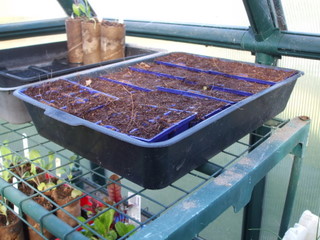
Flats (seedling) – These are broad flat rectangular containers used to hold seedling punnets (which is where you usually see them, in the nursery or Bunnings holding 8 or 10 punnets of veggie seedlings) which can be used to raise seedlings or microgreens by filling with seed raising mixture. You can make them from timber but they need to be well lacquered or regularly disinfected to prevent a build up of disease which can be harboured in the wood. I use the plastic ones for ease of disinfection. 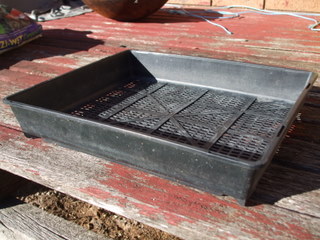
Fork (garden) – Useful for freeing up clay soil to get the dolomite or gypsum in, moving mulch around and indispensable for loosening the soil at the bottom of the spade trench and incorporating manure and other organic material during the process of double digging. The fork is the first tool that will show if you are tight with your money, the first time you use a cheap garden fork one or the other outer tine will bend back turning your fork into non-functional garden sculpture. You won’t hear me say this often, but get the most expensive one you can afford.
Greenhouse – we have a comparatively large one which we use mainly to raise seedlings and giving us early start on the garden in spring by getting well grown capsicums, tomatoes and chillies etc up and running and ready to go. They can be used for out of season cropping and I have done some work with that particularly with tomatoes but in most cases we use it to raise seedlings. It does get extremely hot in the middle of summer so we do use it then for drying out timber and sometimes sterilising compost etc. For raising seedlings the small ones work well too and that was all we had to use in the early days. It does provide a very nice place to work on those clear but cold winter days, too.
High Tech Planting Tool – OK, you got me, it is a paddle pop stick! Next time you get a wonderful chocolate coated ice cream save the stick. I prefer the sportier curvy model but if you like the straight-down-the-line type that is fine too. They are exceptionally handy when manhandling seedlings out of the punnets and ready for potting on or planting out. You know you want one.....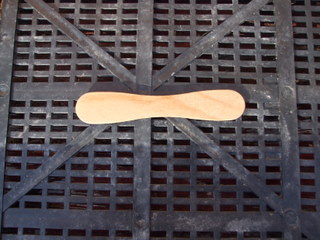
Hoe – my one was inherited from my father in law and is very strong and well made. These days because we do not do much cultivation (the chooks and worms to it for us) or weeding (the mulch helps there) I mostly use our hoe to loosed up the soil after the chooks have been on it and get it ready for mulching and planting. If weeding is your thing you can sharpen the front of the blade with a file and use the hoe to cut off the weeds just below the surface of the soil.
Kneeling Board – this is a frame with a soft padded surface so that when you have to get down on your knees to weed, plant, so or trim you have a soft surface to kneel on. These may not be a necessity but they sure make the job easier and more comfortable. Call me a wimp if you like, but if you do I’ll hit you with my kneeling board!
Labels – it is always important to know what seeds you have planted so a label of some sort is good. They come in thin metal (usually copper or aluminium) that can have the information pressed into them with a pencil or plastic that you use a soft pencil to write on them with. If you are of a mind you can make your own by cutting up an old ice cream container (OK, so I like ice cream.....what about it?) into 1 to 2cm strips with a pair of scissors and then right on them with a soft pencil like a chinagraph pencil.
pH Meter – It is good to know if you are having a problem with your pH (how acid or alkaline your soil is) particularly if you are just starting out. In my experience once you start growing organically the amount of organic matter in the soil tend to keep it around the neutral (7) park anyway. It is good to be able to check though.
Mattock – If you have to do any digging through heavy clay and don’t have a backhoe in your pocket this will help you get through some pretty touch soil. If you are just starting your patch or want to run irrigation or drainage pipes or put in a grey water system a mattock will be invaluable to you. But they do mean hard work so I suggest you wait until you have reasonably sized sons or sons-in-law to take the ache out of your back. If you want to convert your veggie beds to wicking beds you will need a mattock to get down far enough.
Pruning Saw - If you have fruit trees the odds are they will need to be pruned at some point and while secateurs are OK for smaller trees, once they get a bit bigger you will need to have a pruning saw.
Punnets – these come in various shapes and sizes with compartments or not, usually plastic. I did try and make some clay ones a few years ago but they didn’t work – more a testament to my lousy potting skills rather than the concept though I think. If you have been used to buying your seedlings retail than you will probably have a good supply already but if you don’t they can be purchased for a small fee. Unfortunately they will be plastic and will degrade over time and I am currently casting around for a more sustainable replacement but haven’t found one yet. 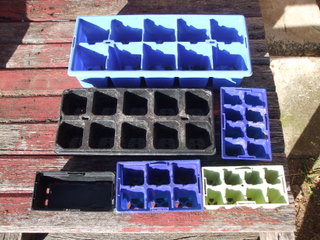
Push Mower – We have grass and while it may not be productive it sure is nice to walk around on or to have a picnic on in the back yard and if you are going to have grass you will want to mow it. I’ve used a push mower for the past 5 years or so and no longer see the point of keeping a loud, petrol gulping fume belching monster employed so I got rid of it. Most urban and suburban yards don’t have huge amounts of lawn anyway so do yourself a favour and get a push mower.
Rake (grass & metal) – the grass rake is good for raking up leaves and cut grass for use as mulch or to compost. I use the metal straight backed rake to smooth out the surface of the veggie patch after I hoe it and to position the mulch on the bed once it is smooth to prevent having to walk on the bed.
Scissors – Whatever your gardening size a pair of dedicated gardening scissors is good to have and I am reliably informed that many divorces and some murders are associated with the husband using the wife’s sewing scissors in the garden. Scissors are good for minor pruning, harvesting of some fruit, vegetables, herbs and microgreens, making labels, cutting string and twine used to secure plants to trellises, opening seed packets – you name it! Make sure they are a good brand though or they won’t be up to the job. (hmm, surely she won’t miss one pair of sewing scissors........)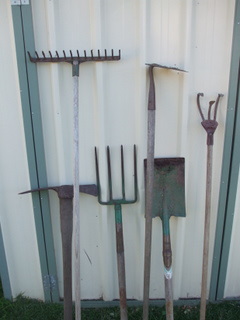
Secateurs – these are for pruning all sorts of plants but particularly fruit trees. Quality is important here because the cheaper ones will not give you a clean cut particularly after they have seen a bit of use. You also need to sharpen them regularly to maintain the clean cut. They come in two types, bypass with a curved blade passing by and unsharpened thick hook, and anvil where a blade which is sharpened both sides closes against an anvil. Bypass secateurs are the best all-round type but the anvil types are good for thicker cuts and removing dead wood.
Sieve – you may not use a sieve often but they come in very handy to break up your own compost or to remove the big lumps from commercial compost if you need a finer particle size, like if you are making your own potting or seed raising mix. We have wood burners and I use the sieve to remove the larger lumps of charcoal from the ash so we can use the ash to fertilise veggie beds and use the charcoal for the forge.
Spade – If you like to dig you gotta have a spade, and I have heard of people who do like to dig.......but I’m not one of them. If you want to double dig, incorporate manure or other organic matter in your soil or just shift the chook poo from the chook house to the veggie patch you need to have a spade and you will also need a spade if you want to convert your veggie beds to wicking beds too. The spade will need to be able to take a fair amount of abuse so don’t go for the cheap import, get an Aussie brand like cyclone or the blade may bend when you don’t want it to. Again, this is a good place to invest more money and get the most expensive one you can afford.
Sprayer – I am not talking about a large backpack sprayer here, we won’t be spraying large amounts of chemical pesticides or herbicides but a small hand sprayer to apply one of the organic pesticides if necessary can be handy. They can also be used to apply foliar fertiliser like biofertiliser where necessary so it is good to have one available.
Trowel – This is probably the most used tool that I have, mainly for planting seedlings or harvesting root veggies, it can also be used for mixing seed raising mixture. The pressed steel ones can bend if you put too much pressure on them so I like the ones with the handle welded on.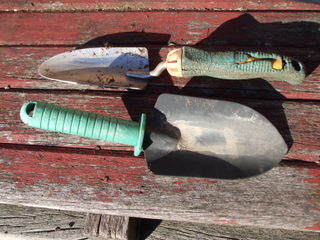
Three Prong Cultivator – These are useful to remove weeds from non mulched areas and to loosen the soil if there has been rain compaction of the surface so that water and air can penetrate. They have a long handle so that you can complete this operation from a standing position.
Watering Can – This one is important, even if you have a small growing area, to allow you to take tank water and apply it to your veggie beds or containers and even to fill self watering containers. The watering can will also come in handy to apply liquid manure and foliar feeds to your veggies but don’t waste money on a light plastic one it will only last a year or two, go for a galvanised steel one and it will save you money in the long run.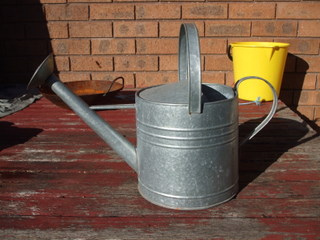
Wheelbarrow – Even in a small yard you may need to transport soil, sand, mulch, bales of hay or straw or bags of manure or chook food and a using a wheelbarrow beats the living daylights out of pick and carry! You can also use the wheelbarrow to mix up larger amounts of potting mix or soil and to rehydrate the large bricks of cocopeat. This is one of those “must have” tools that can make life so much easier.



